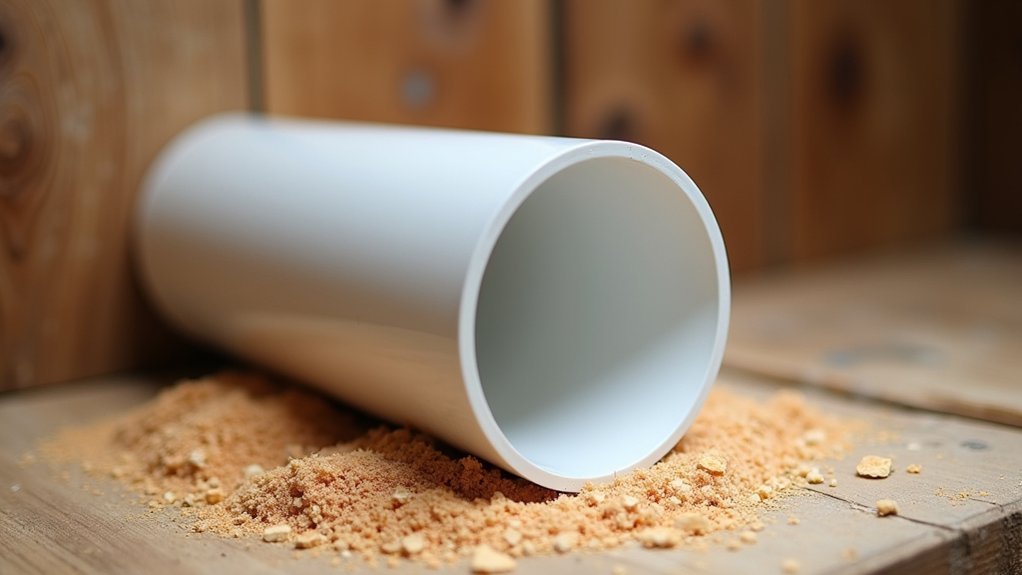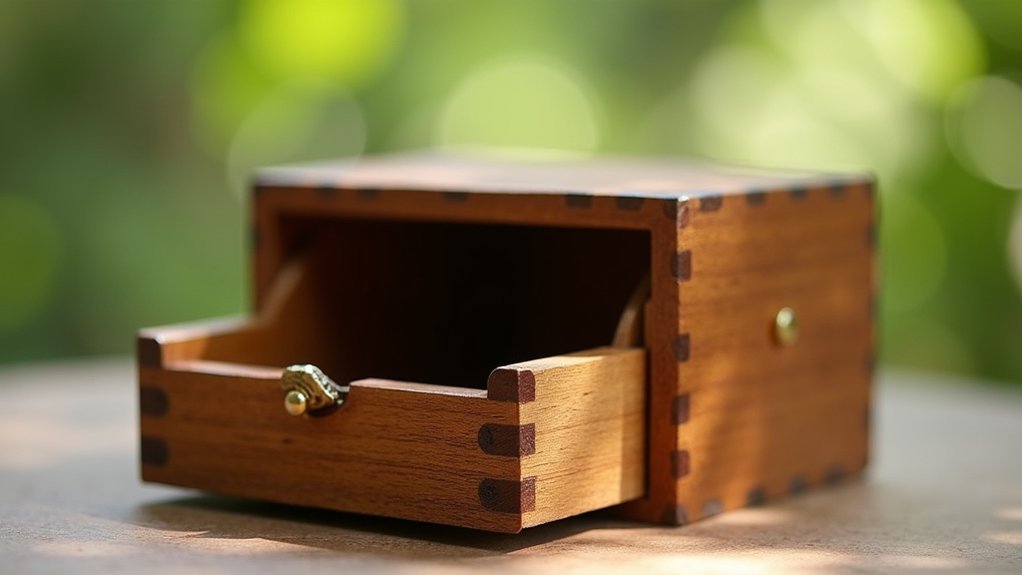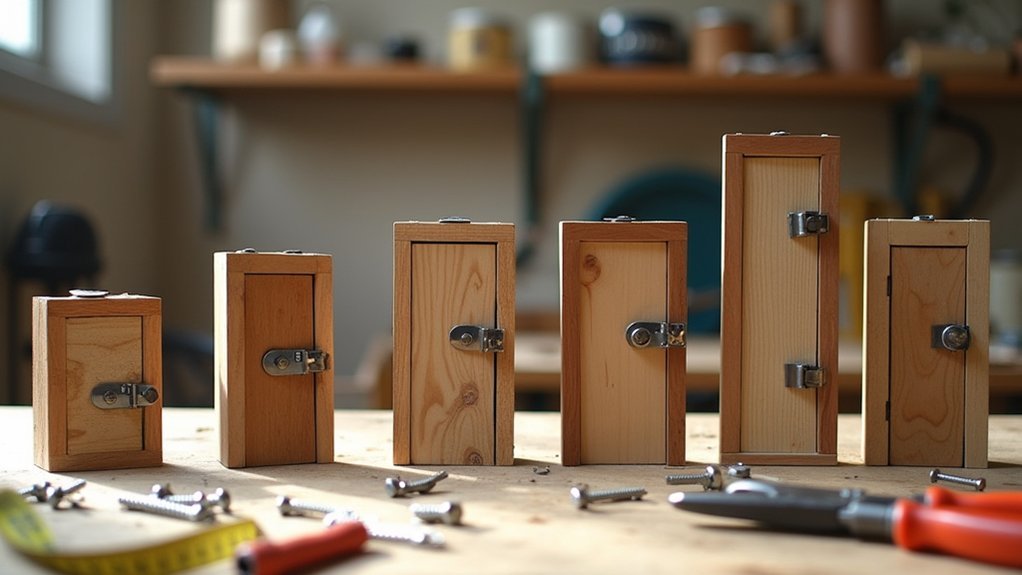Seven easy DIY one-way door traps include PVC pipe funnels for rodents, galvanized hardware cloth excluders, plastic bottle exit systems, spring-loaded door mechanisms for raccoons, wooden box traps with gravity-close doors, mesh wire cone designs for squirrels, and hinged metal flap exclusion devices. You’ll need basic materials like PVC pipes, hardware cloth, plastic bottles, springs, wood, mesh wire, and metal sheets. These humane solutions allow pests to exit but prevent re-entry. Discover how to build these simple yet effective traps below.
PVC Pipe Funnel Trap for Rodents

Three key components make a PVC pipe funnel trap an effective DIY solution for catching rodents.
First, select a 4-6 inch diameter PVC pipe that’s at least 3-4 feet long, creating the perfect tunnel for your unwanted visitors. The one-way door design allows rodents to enter easily but prevents their escape, functioning like a humane capture system.
Second, proper placement maximizes results. Position your trap near known entry points and secure it firmly to the ground to prevent tipping. Remember, rodents prefer traveling along walls and established paths.
Finally, bait selection matters. Place peanut butter or seeds at the far end of the pipe to lure rodents inside. The covered end forces them to exit through your designated opening, completing the trap’s effectiveness.
Galvanized Hardware Cloth Excluder
The sturdy metal mesh of galvanized hardware cloth creates a versatile and durable solution for wildlife exclusion. This rust-resistant material, available in 1/2 inch or 1/4 inch mesh, is perfect for crafting effective one-way doors that allow animals to exit without returning.
To build your excluder, cut a 10-inch square piece of hardware cloth and shape it into a funnel. Secure it firmly to your building using screws and washers, ensuring it can withstand persistent animals trying to re-enter.
Form the tube’s end with inward-angled, pointed edges that facilitate easy exit while preventing re-entry.
Remember to seal all other potential entry points around your property. Your hardware cloth excluder will only work effectively when it becomes the animals’ only available exit route.
Plastic Bottle One-Way Exit System

Simpler household items can often be just as effective as hardware cloth when creating wildlife excluders. The plastic bottle one-way exit system uses a common recyclable to help pests exit your home without returning. Cut a hole in the bottle’s side large enough for the pest, then mount it with the neck facing outward.
| Step | Action |
|---|---|
| 1 | Cut plastic bottle, removing bottom portion |
| 2 | Create entry hole in wall or structure |
| 3 | Mount bottle with neck pointing outward |
| 4 | Secure bottle firmly to prevent dislodging |
| 5 | Check regularly for blockages and effectiveness |
The bottle’s tapered neck creates a natural funnel that allows animals to exit but makes re-entry nearly impossible. They can push through to freedom but can’t navigate the reverse angle to return. Check your system periodically to verify it remains effective.
Spring-Loaded Door Mechanism for Raccoons
Raccoons, with their dexterous paws and problem-solving intelligence, require specially designed exit systems that can withstand their determined attempts to return.
When building spring-loaded one way doors for these clever creatures, focus on durability and proper sizing.
Select robust springs that can resist persistent pushing from the outside while allowing easy outward movement. Construct the door frame to match adult raccoon dimensions—typically 8×10 inches—ensuring they can exit comfortably without injury.
The perfect raccoon exit combines sturdy springs with precise 8×10 dimensions, creating a path out but not back in.
Secure installation is critical. Bolt the mechanism firmly or seal all edges to prevent raccoons from creating alternative entry points.
Once installed, check your one way doors regularly to confirm they’re functioning as intended.
This humane solution lets raccoons leave your space naturally while effectively preventing their return, solving your wildlife intrusion problem without harming the animals.
Wooden Box Trap With Gravity-Close Door

Creating a wooden box trap with a gravity-close door offers a straightforward DIY solution for humanely removing unwanted wildlife from your property. Construct the trap using sturdy wood that can withstand weather and animal activity.
Design the entrance wider than the exit to create a funnel effect, encouraging animals to push through in one direction. When designing the door, make sure it’s heavy enough to fall closed by gravity after an animal exits, preventing re-entry.
Install a simple latch mechanism that releases when the animal pushes outward, allowing the door to automatically close behind them.
For best results, place your trap near known animal pathways and camouflage it with local materials. This strategic positioning greatly increases your chances of successful captures while keeping the trap inconspicuous.
Mesh Wire Cone Design for Squirrels
Constructing an effective mesh wire cone trap starts with folding half-inch hardware cloth into a conical shape with dimensions of approximately 10 inches long and 3 inches wide at the exit point.
You’ll need to create flanges at the base for secure attachment to buildings, ensuring squirrels can’t push their way back through once they’ve exited.
When securing the door safely, bend the interior wire edges inward to prevent injury to squirrels while maintaining a one-way exit that’s impossible for them to re-enter.
Folding The Mesh Properly
Properly folding your mesh wire forms the vital foundation of an effective one-way door trap for squirrels. When working with hardware cloth, make certain you cut it into two main sections—a longer tube piece and a shorter funnel section. The key is creating a cone shape with inward-pointing edges that allows exit but prevents re-entry.
Follow these essential steps for proper folding:
- Bend the edges of the mesh inward to form a cone shape with a 4-6 inch diameter opening suitable for red squirrels.
- Fold all sharp edges securely to prevent animal injuries during exit.
- Secure the folded sections with strong wire or hog clips to maintain structural integrity.
Remember to test the flexibility of your trap before installation, making sure the cone functions properly without collapsing when a squirrel pushes through.
Securing Door Safely
Once you’ve folded your mesh correctly, the safety and security of your one-way door trap depends entirely on proper attachment techniques.
Create strong flanges at the base of your cone to bolt the structure firmly to the building. This prevents determined squirrels from pushing their way back in.
Use 1/2-inch or 1/4-inch hardware cloth for your one-way exit cone—this material offers both durability and the flexibility needed to shape an effective funnel.
Guarantee the inward-pointing edges direct squirrels outward while making re-entry impossible.
Before finalizing installation, seal all alternative entry points around your property. This forces squirrels to use your designated exit.
Implement a regular inspection schedule to check for damage or new access points that could compromise your exclusion system’s effectiveness.
Effective Size Dimensions
The perfect dimensions for your squirrel exclusion device can make the difference between success and failure.
When constructing your mesh wire cone, use half-inch or quarter-inch hardware cloth to prevent smaller animals from squeezing through while allowing squirrels to exit.
For effective size dimensions, follow these key measurements:
- Create an 8-inch long funnel with inward-angled edges to allow easy exit but prevent re-entry.
- Design the exit hole approximately 3×3 inches to accommodate average squirrel size.
- Include secure flanges for bolting the structure to your building, eliminating potential re-entry gaps.
Remember to monitor your one-way door regularly to verify it’s working properly.
With these precise measurements, you’ll create a device that efficiently allows squirrels to leave while preventing their return.
Hinged Metal Flap Exclusion Device
Hinged metal flap exclusion devices offer you an effective way to humanely remove squirrels from your property without harming them.
You’ll need heavy-gauge sheet metal, weather-resistant hinges, and mounting hardware to construct a durable one-way door that prevents re-entry once animals exit.
For best results, install the flap at the main entry point, secure all edges tightly to prevent bypass, and check weekly for proper operation and signs of tampering or wear.
Construction Materials Needed
For building an effective hinged metal flap exclusion device, you’ll need several essential components that guarantee durability and proper functionality. The cornerstone of your project is half-inch or quarter-inch galvanized hardware cloth, which provides the necessary strength to withstand squirrels’ attempts to chew their way back together into your home.
You’ll also require these critical items:
- Cutting tools to shape the hardware cloth into an 8-inch tube with inward-angled ends
- Bolts and mounting hardware to secure the flanges to your structure
- Quality sealant that prevents gaps around the installation site
Don’t forget measuring tools to ascertain proper sizing.
Regular monitoring equipment like a flashlight for inspections will help verify your exclusion device remains effective over time.
Installation Best Practices
With all materials gathered, you’ll now need to focus on proper installation techniques that maximize your exclusion device’s effectiveness.
Install your hinged metal flap so it swings outward only, allowing animals to exit while preventing their return.
Secure the door trap tightly to your building using strong bolts and sealant, eliminating any gaps that might serve as alternative entry points.
The galvanized hardware cloth you’ve selected will withstand persistent animals trying to push their way back in.
Before finalizing installation, seal all secondary entry points completely. Your one-way door trap will only work if it becomes the animal’s sole exit option.
Once installed, monitor the device regularly to verify it’s functioning properly, making adjustments as needed. Regular checks guarantee your exclusion strategy remains effective throughout the removal process.
Maintenance Tips
Once your exclusion device is successfully installed, regular maintenance becomes essential to confirm its continued effectiveness.
You’ll need to inspect the hinged metal flap frequently for signs of wear, corrosion, or damage that might allow animals to come back inside.
Keep your exclusion device functioning properly with these critical maintenance steps:
- Check daily for animal activity around the flap and seal any new entry points immediately.
- Clean the flap and surrounding area regularly to remove debris that might prevent proper closing.
- Test the flap periodically to verify it swings freely and closes securely after an animal exits.
Ascertain the edges remain properly sealed without gaps that could compromise the system.
Proper maintenance prevents pests from returning and extends the life of your exclusion device.
Frequently Asked Questions
How Do You Make a One-Way Door for a Squirrel?
You’ll create a funnel with half-inch hardware cloth about 8 inches long. Angle the exit end inward with pointed edges, secure it firmly to the building, and seal all other entry points completely.
How Do One-Way Traps Work?
One-way traps work like a one-directional valve. You design them with a funnel or door that animals can push through to exit, but can’t re-enter because the opening closes behind them automatically.
Do One-Way Doors Work for Rats?
Yes, one-way doors work effectively for rats. You’ll need to guarantee proper installation, seal all other entry points, and choose the right size door. Placing bait outside can help encourage rats to exit.
What Is a One-Way Exclusion Device?
A one-way exclusion device is a tool you’ll use to let animals exit your home but not re-enter. It features a funnel shape or spring-loaded door that closes behind pests once they’ve left.
In Summary
You’ve now got seven DIY one-way traps that let animals out but not back in. Whether you’re dealing with mice, raccoons, or squirrels, these homemade solutions are both humane and effective. Remember to check your traps regularly and release captured animals at least 5 miles from your property. With basic materials and a little effort, you’ll solve your wildlife problem without breaking the bank.





Leave a Reply